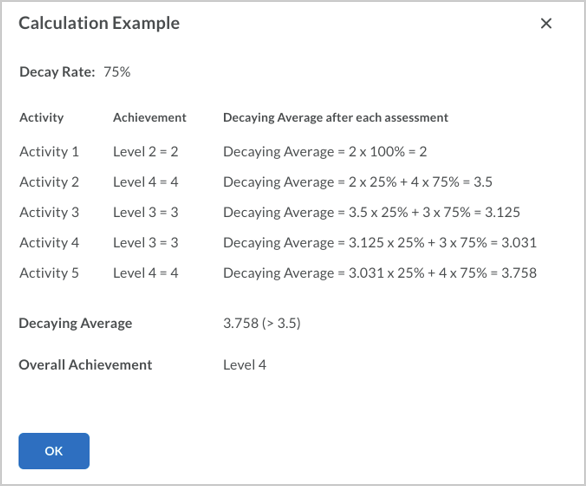Overall Achievement Calculation Settings
The Grade book Mastery View includes four calculation methods:
- Most Common (default)
- Most Recent
- Highest
- Decaying Average
There is also an option for "No Automatic Calculation." This option turns off the suggested level of achievement. The instructor can still manually determine the overall level of achievement for each learner.
The calculation method settings are available in the Settings option of the Mastery View. The settings are also available from the first use alert message which displays the first time you access the Mastery View page.
The first time you use the Mastery View table page, a message appears under the page title to show the default calculation method for the data in the view. The message also provides a link to the Settings page, where you can change the calculation method.
If you attempt to change the default in-use calculation method or turn off the automatic calculations, the achievement levels must be recalculated. If you change the calculation method after evaluation data has been collected, a warning message displays to indicate that the evaluations must be recalculated according to the newly selected method. Any prior evaluations with manual overrides or feedback are not affected by changing calculation methods. If outcome overall achievements are already published, recalculations for the newly selected method are also immediately visible to learners.
Each of the calculation methods provides a calculation example to demonstrate how the overall level of achievement would be determined in a specific scenario. This approach provides clear visibility into the calculation algorithms used to compute the suggested overall level of achievement. For example:

Figure: Calculation example of the Decaying Average calculation method with a decay rate of 75% and 5 activities.
Calculation method: Most Common
The default calculation method is Most Common. This method selects the most frequent level of evaluation (or the statistical mode) from a selected number of assessments or all assessments in the course.
To use the Most Common calculation type:
- In your Grade book, click Mastery.
- Click Settings.
- Click Most Common.
- Choose the activities to use in the calculation and indicate the number of most recently accessed activities you want to include, if applicable.
- Indicate whether you want to use the Highest level or the Most recent level when more than one achievement level has the highest counts.
- Indicate if you want to use the Highest attempt or the Last attempt when learners make multiple attempts on an activity.
Calculation method: Most Recent
You can use the Most Recent evaluation method to represent the learner’s overall level of achievement related to an outcome. This method is convenient in cases where a high-stakes assessment or end-of-course summative assessment is provided to the learner. In those scenarios, the learner’s overall outcome achievement in the course is determined by the evaluation of this assessment. This scenario assumes that the summative assessment is the last (or most recent) assessment in the course.
To use the Most Recent calculation type:
- In your Grade book, click Mastery.
- Click Settings.
- Click Most Recent.
Calculation method: Highest
Use the Highest calculation method if the learner’s overall level of outcome achievement in the course should be represented by the highest level achieved on any individual assessment evaluated with this outcome. This method can be used in cases such as competency-based education models where the learner needs to demonstrate mastery related to an outcome at some point in the course or within a range of assessment activities or submission attempts.
To use the Highest calculation type:
- In your Grade book, click Mastery.
- Click Settings.
- Click Highest.
- Choose the activities to use in the calculation and indicate the number of most recently accessed activities you want to include, if applicable.
Calculation method: Decaying Average
The decaying average calculation method provides a weighted average calculation whereby the older assessment evaluations contribute less to the overall calculation compared to newer assessments. This method also offers the options to limit the scope of calculations to a specified number of assessment activities as well as granular control over multiple submission attempts from learners related to an activity.
Text-only achievement levels are converted to numeric values based on their ordinal numbers. The achievement levels with percentage mapping are converted to the average value of their ranges. Then, the overall achievement is determined by calculating the weighted average of assessments.
To use the Decaying Average calculation type:
- In your Grade book, click Mastery.
- Click Settings.
- Click Decaying Average.
- Indicate the decay rate you want to use.
Note: Use a decaying rate higher than 60% to produce the most reliable scores. - Choose the activities to use in the calculation, and indicate the number of most recently accessed activities you want to include, if applicable.
- Indicate if you want to use the Highest attempt, Last attempt, or Average of all attempts when learners make multiple attempts on an activity.
No Automatic Calculation
Use the No Automatic Calculation option when you do not want a suggested level of achievement for all learners and all outcomes in the course. Instructors can perform manual evaluations to establish a level of achievement within the course; however, there are calculations to provide a suggested level of achievement.